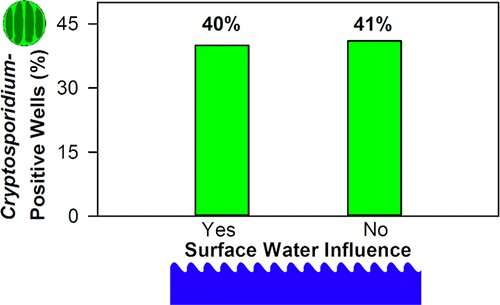Cryptosporidium parasite detected in Minnesota groundwater

When consumed in contaminated water, the microscopic parasite Cryptosporidium can cause symptoms of stomach cramps, diarrhea and fever. Now, researchers reporting in the ACS journal Environmental Science & Technology have detected evidence of the parasite in about 40 percent of surveyed wells in public water systems in Minnesota—even wells not influenced by surface water. The team emphasizes that they don't know whether the parasite levels are high enough to actually cause health concerns.
Most Cryptosporidium outbreaks associated with drinking water sources have been traced to surface waters such as lakes and rivers that become contaminated by sewage discharge or livestock runoff. In contrast, water from aquifers deep within the ground was not thought to be as vulnerable because the overlying soil and sediments can filter out Cryptosporidium oocysts. The U.S. Environmental Protection Agency requires that public water systems with a surface water source monitor and treat for Cryptosporidium contamination, whereas groundwater is exempt from these regulations unless known to be infiltrated by surface waters. Mark Borchardt and colleagues at the U.S. Department of Agriculture-Agricultural Research Service, U.S. Geological Survey and Minnesota Department of Health wondered if they could detect Cryptosporidium parasites in public water system wells with variable surface water influences.
Over a two-year period, the researchers collected water samples from 145 wells supplying public water systems across the state of Minnesota. They tested for Cryptosporidium DNA with a sensitive technique called quantitative polymerase chain reaction (qPCR). The team found that 40 percent of the wells tested positive for Cryptosporidium at least once, while 15 percent were positive more than once. The standard microscopic method also showed Cryptosporidium in some of the wells. The prevalence and levels of contamination were similar regardless of whether groundwater was influenced by surface water. These results suggest that soil may not completely prevent Cryptosporidium oocysts from reaching groundwater, and therefore, "monitoring and treatment measures should be considered for groundwater-supplied public water systems," the researchers say. The new findings also indicate that additional work is needed to better understand how the Cryptosporidium got into deep groundwater wells and to characterize potential health threats.
More information: Joel P. Stokdyk et al. Cryptosporidium Incidence and Surface Water Influence of Groundwater Supplying Public Water Systems in Minnesota, USA, Environmental Science & Technology (2019). DOI: 10.1021/acs.est.8b05446
Journal information: Environmental Science & Technology
Provided by American Chemical Society




















